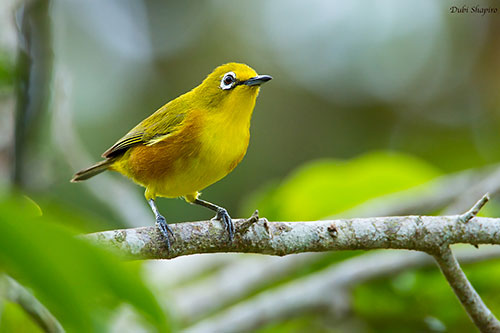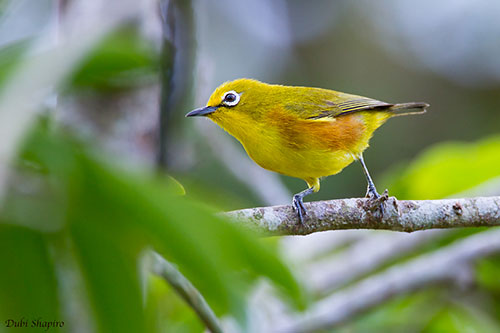
The Mayotte White-eye is probably sedentary.
The flight is weak and undulating, only performed over short distances.
REPRODUCTION OF THIS SPECIES:
The breeding season probably starts in September/October.
The Mayotte White-eye builds a cup-shaped nest, usually a small open cup made with fine plant fibres. It is usually covered with fine grasses and spider webs on the outer part of the structure.
The nest is built in lateral fork of dense bush, about two metres above the ground.
No more information.
PROTECTION / THREATS / STATUS:
The Mayotte White-eye is a restricted-range species, described as common to fairly common. However, the species is threatened by destruction and fragmentation of the habitat and by introduced predators.
The size of the population is unknown, but it is suspected to be declining.
But currently, the Mayotte White-eye is not globally threatened and evaluated as Least Concern.
Fr: Zostérops de Mayotte
Ang: Mayotte White-eye – Chestnut-sided White-eye
All: Dotterbrust-Brillenvogel
Esp: Anteojitos de la Mayotte
Ita: Occhialino di Mayotte
Nd: Mayottebrilvogel
Sd: mayotteglasögonfågel
Photographer:
Dubi Shapiro
Dubi Shapiro Photo Galleries & Dubi Shapiro's Pictures on IBC
Text by Nicole Bouglouan
Sources :
HANDBOOK OF THE BIRDS OF THE WORLD Vol 13 by Josep del Hoyo-Andrew Elliot-Jordi Sargatal - Lynx Edicions – ISBN: 9788496553453
OISEAUX des ÎLES DE L’OCÉAN INDIEN De Ian Sinclair – Editeur : Penguin Random House South Africa, 2013 – ISBN : 1775840727, 9781775840725 - 263 pages
The Birds of Africa: Volume VIII: The Malagasy Region: Madagascar, Seychelles, Comoros, Mascarenes - Par Roger Safford, Frank Hawkins – ISBN: 1408190494, 9781408190494- Editeur: A&C Black, 2013
Home page
Page Passeriformes Order
Mayotte White-eye or Chestnut-sided White-eye
Zosterops mayottensis
Passeriformes Order – Zosteropidae Family
INTRODUCTION:
The Mayotte White-eye or Chestnut-sided White-eye is endemic to Mayotte Island in the Comoros Archipelago. It is the only white-eye of this island.
It is mainly found in forests and more open wooded areas where it feeds on plant matter, nectar and insects. It nests in a cup-shaped structure placed in dense bush.
The Mayotte White-eye or Chestnut-sided White-eye is described as common to fairly common throughout its restricted range, but the species is vulnerable to habitat destruction.
DESCRIPTION OF THE BIRD:
Biometrics:
Length: 11 cm
Weight: 9-10 g
The Mayotte White-eye has greenish-yellow crown and upperparts, but flight-feathers and rectrices are blackish with greenish-yellow edges on the outer webs. The flight-feathers also show broad white edges to inner webs.
The underparts are bright lemon-yellow, including the underwing-coverts. The flanks are tinged chestnut, giving the bird its second name “Chestnut-sided White-eye”.
On the head, the forehead is bright lemon-yellow, whereas crown is mostly greenish-yellow. The lores are blackish. The conspicuous eyering is white.
The pointed bill is blackish-blue with grey base to lower mandible. The eyes are reddish-brown. Legs and feet are dark grey.
Male and female are similar.
The juvenile is less yellow than adults, with mostly greener upperparts. The underparts are duller, with reduced chestnut area on flanks.

RANGE:
The Mayotte White-eye is endemic to Mayotte Island, and also occurs on Petite Terre in SE Comoros Islands.
HABITAT:
The Mayotte White-eye frequents forests, more open wooded areas and mangroves. This species occurs mainly in dry habitats and is rarer in the rainforest.
CALLS AND SONGS: SOUNDS BY XENO-CANTO
The members of genus Zosterops are highly vocal with far-carrying voices. Contact calls can be heard at all times of the day, but mainly in early morning and late afternoon.
The song of the Mayotte White-eye and most Zosterops species is usually compared to the sound of a telegraph message transmitted by Morse code. It is a series of single notes, high or low notes.
BEHAVIOUR IN THE WILD:
The Mayotte White-eye feeds mainly on insects, caterpillars and spiders. But its diet also includes fruits, berries and nectar.
It clings to flowers with the feet held wide apart and with the neck held forwards. Each flower is briefly visited, and the brush-tipped tongue allows the bird to suck up nectar.
The Mayotte White-eye usually forages in small groups in trees and shrubs, calling constantly while moving.
Nothing is known about the courtship displays, but we can suggest that the conspicuous white eyering and the chestnut flanks are exposed during the displays.
